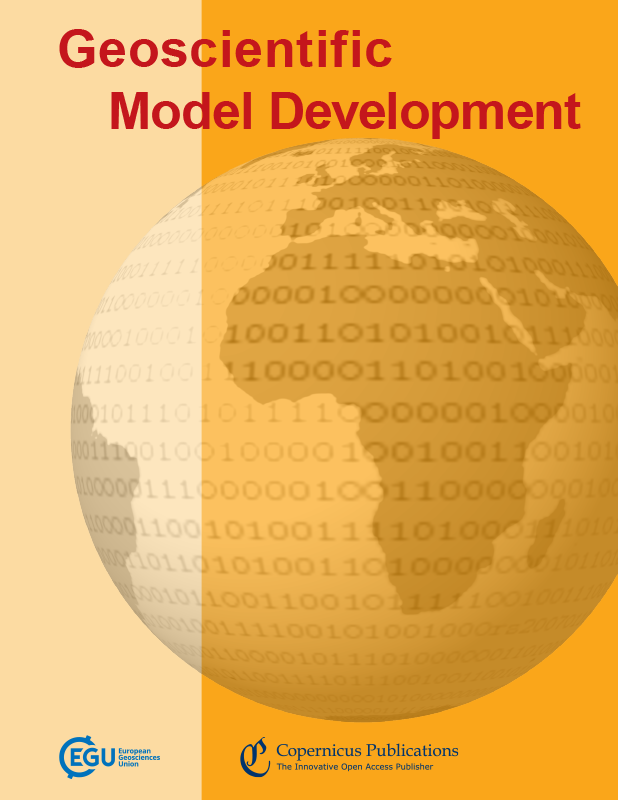A two-way coupled regional urban–street network air quality model system for Beijing, China
IF 4.9
3区 地球科学
Q1 GEOSCIENCES, MULTIDISCIPLINARY
引用次数: 0
Abstract
Abstract. Owing to the substantial traffic emissions in urban areas, especially near road areas, the concentrations of pollutants, such as ozone (O3) and its precursors, have a large difference compared to regional averages, and their distributions cannot be captured accurately by traditional single-scale air quality models. In this study, a new version of a regional urban–street network model (an Integrated Air Quality Modeling System coupling regional urban–street: IAQMS-street v2.0) is presented. An upscaling module is implemented in IAQMS-street v2.0 to calculate the impact of mass transfer to regional scale from street network. The influence of pollutants in the street network is considered in the concentration calculation on the regional scale, which is not considered in a previous version (IAQMS-street v1.0). In this study, the simulated results in Beijing during August 2021, using IAQMS-street v2.0, IAQMS-street v1.0, and the regional model (Nested Air Quality Prediction Modeling System, NAQPMS), are compared. On-road traffic emissions in Beijing, as the key model input data, were established using intelligent image-recognition technology and real-time traffic big data from navigation applications. The simulated results showed that the O3 and nitrogen oxide (NOx) concentrations in Beijing were reproduced by using IAQMS-street v2.0 on both the regional scale and street scale. The prediction fractions within a factor of 2 (FAC2s) between simulations and observations of NO and NO2 increased from 0.11 and 0.34 in NAQPMS to 0.78 and 1.00 in IAQMS-street v2.0, respectively. The normalized mean biases (NMBs) of NO and NO2 decreased from 2.67 and 1.33 to −0.25 and 0.08. In the coupled model, the concentration of NOx at the street scale is higher than that at the regional scale, and the simulated distribution of pollutants on a regional scale was improved in IAQMS-street v2.0 when compared with that in IAQMS-street v1.0. We further used IAQMS-street v2.0 to quantify the contribution of local on-road traffic emissions to the O3 and NOx emissions and analyze the effect of traffic regulation policies in Beijing. Results showed that heavy-duty trucks are the major source of on-road traffic emissions of NOx. The relative contributions of local traffic emissions to NO2, NO, and O3 concentrations were 53.41 %, 57.45 %, and 8.49 %, respectively. We found that traffic regulation policies in Beijing largely decreased the concentrations of NOx and hydrocarbons (HC); however, the O3 concentration near the road increased due to the decrease consumption of O3 by NO. To decrease the O3 concentration in urban areas, controlling the local emissions of HC and NOx from other sources requires consideration.北京双向耦合区域城市街道网络空气质量模型系统
摘要由于城市地区特别是道路附近的大量交通排放,臭氧(O3)及其前体等污染物的浓度与区域平均值相比有很大差异,传统的单尺度空气质量模式无法准确捕捉其分布。本文提出了一个新版本的区域城市街道网络模型(耦合区域城市街道的综合空气质量建模系统:IAQMS-street v2.0)。在IAQMS-street v2.0中实现了一个升级模块,用于计算街道网络传质对区域尺度的影响。在区域尺度的浓度计算中考虑了街道网络中污染物的影响,这在之前的版本(IAQMS-street v1.0)中没有考虑。采用IAQMS-street v2.0、IAQMS-street v1.0和区域模式(Nested Air Quality Prediction Modeling System, NAQPMS)对北京地区2021年8月的模拟结果进行了比较。北京市道路交通排放作为关键模型输入数据,采用智能图像识别技术和导航应用实时交通大数据建立。模拟结果表明,IAQMS-street v2.0在区域尺度和街道尺度上均能再现北京市O3和氮氧化物(NOx)浓度。NAQPMS和IAQMS-street v2.0中NO和NO2模拟值与观测值之间的因子2内预测分数(FAC2s)分别从0.11和0.34增加到0.78和1.00。NO和NO2的标准化平均偏差(nmb)从2.67和1.33降至- 0.25和0.08。在耦合模型中,街道尺度的NOx浓度高于区域尺度,IAQMS-street v2.0对污染物在区域尺度上的模拟分布较IAQMS-street v1.0有所改善。利用IAQMS-street v2.0量化了北京市道路交通排放对O3和NOx排放的贡献,并分析了交通管制政策的效果。结果表明,重型卡车是道路交通NOx排放的主要来源。当地交通排放对NO2、NO和O3浓度的相对贡献分别为53.41%、57.45%和8.49%。研究发现,北京市交通管制政策在很大程度上降低了氮氧化物和碳氢化合物的浓度;然而,由于NO对O3的消耗减少,道路附近的O3浓度增加。为了降低城市地区的O3浓度,需要考虑控制其他来源的HC和NOx的局部排放。
本文章由计算机程序翻译,如有差异,请以英文原文为准。
求助全文
约1分钟内获得全文
求助全文
来源期刊

Geoscientific Model Development
GEOSCIENCES, MULTIDISCIPLINARY-
CiteScore
8.60
自引率
9.80%
发文量
352
审稿时长
6-12 weeks
期刊介绍:
Geoscientific Model Development (GMD) is an international scientific journal dedicated to the publication and public discussion of the description, development, and evaluation of numerical models of the Earth system and its components. The following manuscript types can be considered for peer-reviewed publication:
* geoscientific model descriptions, from statistical models to box models to GCMs;
* development and technical papers, describing developments such as new parameterizations or technical aspects of running models such as the reproducibility of results;
* new methods for assessment of models, including work on developing new metrics for assessing model performance and novel ways of comparing model results with observational data;
* papers describing new standard experiments for assessing model performance or novel ways of comparing model results with observational data;
* model experiment descriptions, including experimental details and project protocols;
* full evaluations of previously published models.
 求助内容:
求助内容: 应助结果提醒方式:
应助结果提醒方式:


